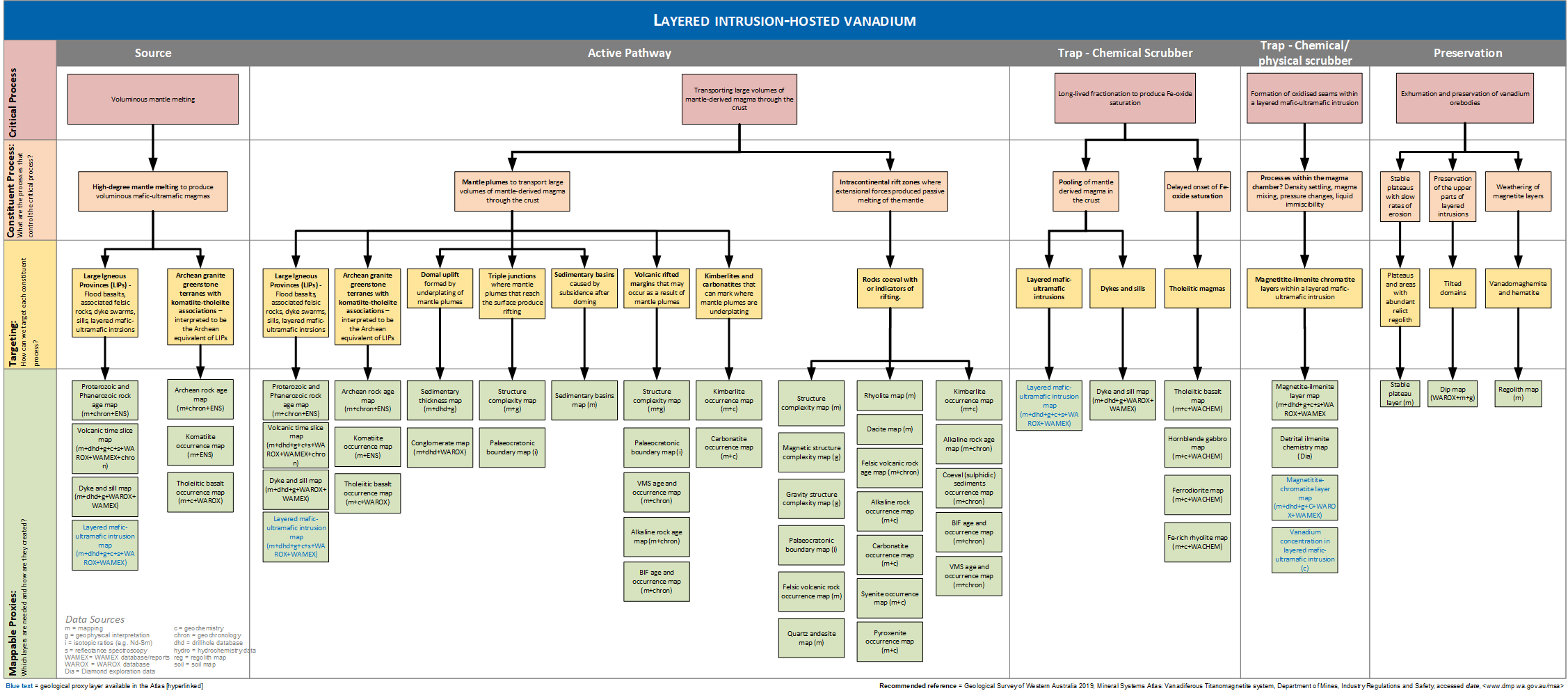Layered mafic–ultramafic intrusion-hosted vanadium deposits in Western Australia account for the majority of Australia’s vanadium resources, and include world-class examples at Speewah, Gabanintha and Windimurra.
Targeted ore types
Vanadium forms as a solid solution within discrete magnetite and ilmenite layers that are concordant to igneous layering within layered mafic–ultramafic intrusions (Kelley et al., 2017). Magnetite and ilmenite can be either disseminated or massive, with vanadium present as grades between 0.2 and 1% V2O5 (Reynolds, 1985).
Mineralization processes
The primary source of vanadium is the mantle, where it was incorporated into mafic melts that formed initially by partial melting in rising mantle plumes or upwelling asthenosphere during lithospheric thinning. These melts then rose and were emplaced into the crust within intracontinental rift zones where they could pond and fractionate (Allen et al., 1995; Ernst and Buchan, 2001; Cawthorn et al., 2005). Magmas with tholeiitic compositions experienced delayed onset of iron oxide saturation, which allowed vanadium to concentrate in the residual melt (Nebel et al., 2013). Upon iron oxide saturation, magnetite and ilmenite start to crystallize into discrete layers concordant with other igneous mineral layering, preferentially sequestering vanadium in solid solution within their structure (Kelley et al., 2017). The formation of this distinct magnetite and ilmenite layering is poorly understood — proposed mechanisms include liquid immiscibility, mineral settling, and increases in oxygen fugacity and pressure (Cawthorn et al., 2005; Kelley et al., 2017).
Critical features
Derived layers are grouped based on their critical features:
SOURCE — voluminous mantle-derived magmas that source vanadium from the mantle.
PATHWAY — evidence for mantle plumes or intracontinental rift zones to transport magma into the crust.
CHEMICAL TRAP — anhydrous magmas that delay iron oxide saturation and allow vanadium to concentrate in the melt.
PHYSICAL TRAP — chemical/mechanical processes that generate magnetite layers within layered intrusions.
PRESERVATION — sufficient uplift and erosion of overlying crust to expose the layered intrusions and orebodies, but not destroy them.
Mineral system analysis
The Mineral System Tree is the graphical display of a mineral system analysis showing the link between Critical/Constituent processes and their recommended targeting features and GIS layers.
References
Allen, DJ, Braile, LW, Hinze, WJ and Mariano, J 1995, Chapter 10 The midcontinent rift system, U.S.A.: A major Proterozoic continental rift, in Continental rifts: evolution, structure, tectonics (1st ed.) edited by KH Olsen: Elsevier, Developments in geotectonics, p. 375–407.
Cawthorn, RG, Barnes, S-J, Ballhaus, C and Malitch, KN 2005, Platinum-group element, chromium and vanadium deposits in mafic and ultramafic rocks, in Economic Geology 100th Anniversary Volume: 1905–2005 edited by JW Hedenquist, JFH Thompson, R Goldfarb and J Richards: Society of Economic Geologists, Ottawa, Canada, p. 215–250.
Ernst, RE and Buchan, KL 2001, Large mafic magmatic events through time and links to mantle plume heads, in Mantle plumes: their identification through time edited by RE Ernst and K Buchan: Geological Society of America, Special Paper 352, p. 483–575.
Kelley, KD, Scott, CT, Polyak, DE and Kimball, BE 2017, Vanadium: Chapter U, in Critical mineral resources of the United States — Economic and environmental geology and prospects for future supply edited by KJ Schulz, JH DeYoung, RR Seal and DC Bradley: United States Geological Survey, Professional Paper 1802, p. U1–U36, doi:10.3133/pp1802U.
Nebel, O, Arculus, RJ, Ivanic, TJ, Rapp, R and Wills, KJA 2013, Upper Zone of the Archean Windimurra layered mafic intrusion, Western Australia: Insights into fractional crystallisation in a large magma chamber: Journal of Mineralogy and Geochemistry, v. 191, no. 1, p. 83–107.
Reynolds, IM 1985, The nature and origin of titaniferous magnetite-rich layers in the upper zone of the Bushveld Complex; a review and synthesis: Economic Geology, v. 80, no. 4, p. 1089–1108, doi:10.2113/gsecongeo.80.4.1089.
Recommended reading
Guilliamse, JN 2020, Layered intrusion-hosted vanadium: a mineral systems analysis: Geological Survey of Western Australia, Record 2020/9, 5p.
Cawthorn, RG, Barnes, S-J, Ballhaus, C and Malitch, KN 2005, Platinum-group element, chromium and vanadium deposits in mafic and ultramafic rocks, in One hundredth anniversary volume edited by JW Hedenquist, JFH Thompson, RJ Goldfarb and JP Richards: Economic Geology, p. 215–250.
Kelley, KD, Scott, CT, Polyak, DE and Kimball, BE 2017, Vanadium: Chapter U, in Critical mineral resources of the United States — Economic and environmental geology and prospects for future supply edited by KJ Schulz, JH DeYoung, RR Seal and DC Bradley: United States Geological Survey, Professional Paper 1802, p. U1–U36, doi:10.3133/pp1802U.

